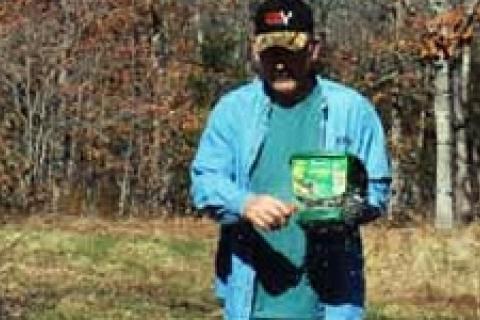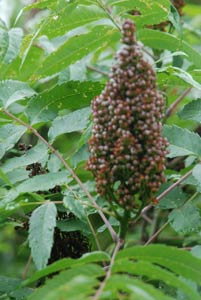
The food plot business in the United States has grown to gargantuan proportions in the last decade. Thousands of hunters and landowners spend untold millions of dollars every year locating, clearing, plowing, planting and cultivating food plots for white-tailed deer. All too often these prospective deer managers overlook the already existing species of native and introduced species of plants that deer will readily eat. Combining these already existing plants with additional food plot plantings is a sure fire way to provide your deer herd the best nutritionally sound food sources available, while reducing food plot costs at the same time.
 |
| Wild plants, such as sumac, are important food sources for white-tailed deer. Utilizing available wild plants along with additional food plantings maximizes the food sources available to deer herds. |
The first step in improving the quality of the forage base on your property is to learn to identify wild plants. Field guides are available at book stores across the country which will help in learning to identify trees, shrubs, grasses, forbs and legumes. Check with your local conservation agent or visit your nearest conservation department office. They will have free pamphlets and booklets that will also help. County agricultural offices and Natural Resources Conservation Service offices may have helpful information as well. And online sources of information are growing steadily.
Being able to identify plants found in your specific area will go a long way towards speeding up the progress of your food plot management plan. Lack of knowledge of such plants appears to be one of the biggest limiting factors of food plot success.
Deer are known to eat an amazingly wide variety of plants. Primarily, their diet consists of browse, soft mast, hard mast, mushrooms, wild grasses, forbs, agricultural crops and landscaping plants.
Browse includes leaves, stems and buds of woody plants and is generally available all year long. Browse is a staple food for deer making up a large part of their total diet. However, a preferred browse in one area may not be the preferred browse in another area.
Both soft and hard mast is seasonably important to deer. Soft mast consists of fruits and berries such as persimmons, blackberries, wild plums, apples, wild cherries, mulberries and crabapples. Hard mast includes acorns, pecans and beechnuts. Forbs include wildflowers, lespedezas, clovers and other broad-leaved weedy plants such as dock, cresses and plantains. They are eaten any time they are available.
Grasses are relatively unimportant to the diet of deer. Deer do eat grasses, but usually only when the plants are young and tender. Farmers know all too well how attractive agriculture crops are to deer. Corn, soybeans, peas, grains, alfalfa, sunflowers and fruits and vegetables are relished by deer.
The bottom line is that deer like a lot of variety in their menu. And they eat a lot. They may eat up to six pounds of food per hundred pounds of body weight each day. Many humans weigh approximately 200 pounds. I can't imagine eating 12 pounds of food in one day, however. That translates roughly to a ton of food per year per deer. That food is found from ground level up to 4 1/2 feet above the ground. Anything taller is out of reach, unless it falls to the ground.
 |
| Applying fertilizer to selected white oak trees is an excellent method to increase acorn production. White oake acorns are a favorite food of white-tailed deer. |
Livestock will eat most plants favored by deer. Fertilized food plots offer better quality food for deer and livestock as well. It will be largely a waste of time to fertilize habitats for deer if cattle are not kept out of the plot.
Every deer hunter knows that deer are extremely fond of white oak acorns. They will eat the acorns of black oaks as well, but distinctly prefer the much sweeter flesh of the white oak acorns. All of us have experienced years when white oak acorns were so plentiful that deer failed to utilize food plot to any extent. Fortunate deer hunters have white oak trees in or near their food plots.
White oaks will respond to fertilizer when applied correctly. One of the biggest mistakes hunters and landowners make when fertilizing white oaks is failure to study the trees ahead of time. Not all trees are created equal. Trees located in places where they have ample moisture, sunlight, and little competition may begin to produce mast at an early age. However, trees living in poor conditions may be 50 years old before they produce acorns, if they produce at all. The moral of the story is to check which trees produce the most acorns. Concentrate your fertilizing efforts on them. They can be made to produce more.
Granular fertilizer, in 13-13-13, is commonly used to fertilize oak trees. Apply the fertilizer at a rate of 2 pounds per 1,000 square feet of crown. A tree with a crown of 80-by-80, or 6,400 square feet, would need 13 pounds of fertilizer. Begin at the outside edge of the dripline and scatter the fertilizer evenly to within three feet of the trunk. Fertilizer should be applied in the spring.
A second method is to use fertilizer spikes, which can be purchased at garden centers. They are more expensive than granular fertilizers, but much easier to carry into the woods. Follow the manufacturer's recommendations for application.
Improving your food plots is not only a lot of fun and a great way to relax in the outdoors; it is also the most sure fire way to improve the quality and quantity of deer in your area. Results do, however, take time, so be patient. It's just another way to improve your patience skills. You will need them when deer season rolls around.
Spring is the time to prepare your food plots. Remember to combine your plantings with those of existing wild pants to reach the full potential of your plot. If you manage to the max, you can depend on wild foods enough that you will only have to add supplemental plantings every two or three years. Another option is to alternate areas every year, leaving one part of the plot in natural food sources while planting the other and then rotate them the following year.
Follow these suggestions and add a few of your own. You will reap bountiful rewards — maybe fine venison for the freezer and/or that trophy buck of your dreams.
- 4500 views

